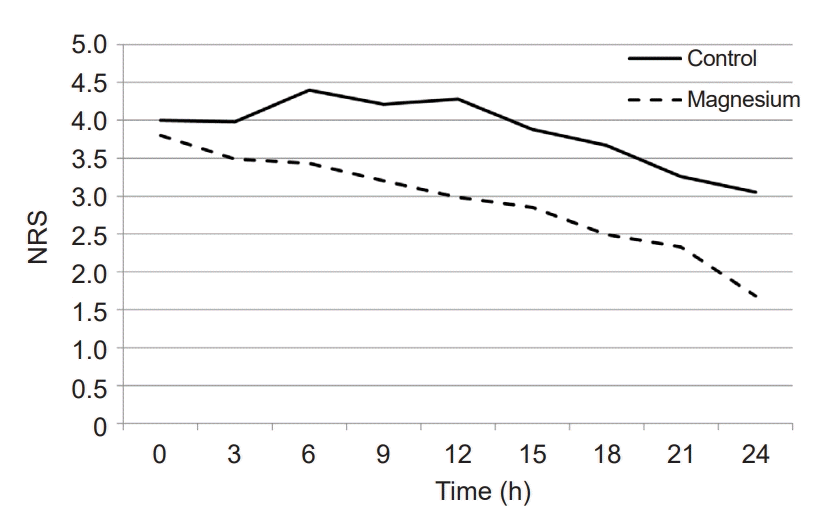1. Wu CL, Fleisher LA. Outcomes research in regional anesthesia and analgesia. Anesth Analg. 2000; 91:1232–42.

2. Camu F, Van Aken H, Bovill JG. Postoperative analgesic effects of three demand-dose sizes of fentanyl administered by patient-controlled analgesia. Anesth Analg. 1998; 87:890–5.

3. Kehlet H, Wilmore DW. Multimodal strategies to improve surgical outcome. Am J Surg. 2002; 183:630–41.

4. Buvanendran A, McCarthy RJ, Kroin JS, Leong W, Perry P, Tuman KJ. Intrathecal magnesium prolongs fentanyl analgesia: a prospective, randomized, controlled trial. Anesth Analg. 2002; 95:661–6.

5. Fuchs-Buder T, Wilder-Smith OH, Borgeat A, Tassonyi E. Interaction of magnesium sulphate with vecuronium-induced neuromuscular block. Br J Anaesth. 1995; 74:405–9.
6. Bhatia A, Kashyap L, Pawar DK, Trikha A. Effect of intraoperative magnesium infusion on perioperative analgesia in open cholecystectomy. J Clin Anesth. 2004; 16:262–5.

7. Steinlechner B, Dworschak M, Birkenberg B, Grubhofer G, Weigl M, Schiferer A, et al. Magnesium moderately decreases remifentanil dosage required for pain management after cardiac surgery. Br J Anaesth. 2006; 96:444–9.

8. Ryu JH, Kang MH, Park KS, Do SH. Effects of magnesium sulphate on intraoperative anaesthetic requirements and postoperative analgesia in gynaecology patients receiving total intravenous anaesthesia. Br J Anaesth. 2008; 100:397–403.

9. De Oliveira GS Jr, Castro-Alves LJ, Khan JH, McCarthy RJ. Perioperative systemic magnesium to minimize postoperative pain: a meta-analysis of randomized controlled trials. Anesthesiology. 2013; 119:178–90.
10. Shin HJ, Na HS, Do SH. Magnesium and pain. Nutrients. 2020; 12:2184.

11. Albrecht E, Kirkham KR, Liu SS, Brull R. The analgesic efficacy and safety of neuraxial magnesium sulphate: a quantitative review. Anaesthesia. 2013; 68:190–202.

12. Jerkovic D, Tadin A, Gavic L, Vladislavic NZ, Grgic N, Macan D. Effect of orally administered magnesium on postoperative pain level and trismus after surgical removal of the lower third molars: a randomized, double-blind, placebo-controlled trial. Clin Oral Investig. 2020; 24:4649–59.

13. Sane S, Mahdkhah A, Golabi P, Hesami SA, Kazemi Haki B. Comparison the effect of bupivacaine plus magnesium sulfate with ropivacaine plus magnesium sulfate infiltration on postoperative pain in patients undergoing lumbar laminectomy with general anesthesia. Br J Neurosurg;2020. doi:
10.1080/02688697.2020.1861430. [Epub ahead of print].
14. Gilani MT, Zirak N, Razavi M. Accidental intrathecal injection of magnesium sulfate for cesarean section. Saudi J Anaesth. 2014; 8:562–4.

15. Kashefi P, Montazeri K, Honarmand A, Moradi A, Masoomi SG. Adding magnesium to lidocaine for intravenous regional anesthesia. J Res Med Sci. 2008; 13:108–14.
16. Peyvandi Yazdi A, Hashemi E, Salehi M, Masoumzadeh M, Razavi M. Evaluation of the prevalence of hypomagnesemia in the first 24th hour after selective operations in intensive care unit patients. OFOGH-E-DANESH. 2014; 20:29–33.
17. Moon S, Lim S, Yun J, Lee W, Kim M, Cho K, et al. Additional effect of magnesium sulfate and vitamin C in laparoscopic gynecologic surgery for postoperative pain management: a double-blind randomized controlled trial. Anesth Pain Med (Seoul). 2020; 15:88–95.

18. Kaya S, Kararmaz A, Gedik R, Turhanoğlu S. Magnesium sulfate reduces postoperative morphine requirement after remifentanil-based anesthesia. Med Sci Monit. 2009; 15:PI5–9.
19. Ozcan PE, Tugrul S, Senturk NM, Uludag E, Cakar N, Telci L, et al. Role of magnesium sulfate in postoperative pain management for patients undergoing thoracotomy. J Cardiothorac Vasc Anesth. 2007; 21:827–31.

20. Dabbagh A, Elyasi H, Razavi SS, Fathi M, Rajaei S. Intravenous magnesium sulfate for post-operative pain in patients undergoing lower limb orthopedic surgery. Acta Anaesthesiol Scand. 2009; 53:1088–91.

21. Shin HJ, Kim EY, Na HS, Kim TK, Kim MH, Do SH. Magnesium sulphate attenuates acute postoperative pain and increased pain intensity after surgical injury in staged bilateral total knee arthroplasty: a randomized, double-blinded, placebo-controlled trial. Br J Anaesth. 2016; 117:497–503.

22. Varas V, Bertinelli P, Carrasco P, Souper N, Álvarez P, Danilla S, et al. Intraoperative ketamine and magnesium therapy to control postoperative pain after abdominoplasty and/or liposuction: a clinical randomized trial. J Pain Res. 2020; 13:2937–46.
23. Shi L, Zhu H, Ma J, Shi LL, Gao F, Sun W. Intra-articular magnesium to alleviate postoperative pain after arthroscopic knee surgery: a meta-analysis of randomized controlled trials. J Orthop Surg Res. 2021; 16:111.

24. Albrecht E, Kirkham KR, Liu SS, Brull R. Peri-operative intravenous administration of magnesium sulphate and postoperative pain: a meta-analysis. Anaesthesia. 2013; 68:79–90.

25. Mehraein A, Azad MA, Sadeghi M. The analgesic effect of magnesium sulfate in postoperative pain of inguinal hernia repair. Tehran Univ Med J. 2007; 65:55–8.
26. Wilder-Smith OH, Arendt-Nielsen L, Gäumann D, Tassonyi E, Rifat KR. Sensory changes and pain after abdominal hysterectomy: a comparison of anesthetic supplementation with fentanyl versus magnesium or ketamine. Anesth Analg. 1998; 86:95–101.
27. Salman N, Olgunkeleş B, Bektaş U, Güner D, Bektas M, Ay Ş, et al. [Effects of intraarticular tramadol, magnesium and ketamine on postoperative pain in arthroscopic meniscectomy]. Braz J Anesthesiol. 2019; 69:35–41. Portuguese.

28. Lee JH, Choi S, Lee M, Jang YE, Kim EH, Kim JT, et al. Effect of magnesium supplementation on emergence delirium and postoperative pain in children undergoing strabismus surgery: a prospective randomised controlled study. BMC Anesthesiol. 2020; 20:289.

29. Ferasatkish R, Dabbagh A, Alavi M, Mollasadeghi G, Hydarpur E, Moghadam AA, et al. Effect of magnesium sulfate on extubation time and acute pain in coronary artery bypass surgery. Acta Anaesthesiol Scand. 2008; 52:1348–52.

30. Hwang JY, Na HS, Jeon YT, Ro YJ, Kim CS, Do SH. I.V. infusion of magnesium sulphate during spinal anaesthesia improves postoperative analgesia. Br J Anaesth. 2010; 104:89–93.

31. Altman D, Carroli G, Duley L, Farrell B, Moodley J, Neilson J, et al. Magpie Trial Collaboration Group. Do women with pre-eclampsia, and their babies, benefit from magnesium sulphate? The Magpie trial: a randomised placebo-controlled trial. Lancet. 2002; 359:1877–90.




 PDF
PDF Citation
Citation Print
Print





 XML Download
XML Download